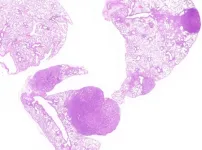(Press-News.org) Below please find summaries of new articles that will be published in the next issue of Annals of Internal Medicine. The summaries are not intended to substitute for the full articles as a source of information. This information is under strict embargo and by taking it into possession, media representatives are committing to the terms of the embargo not only on their own behalf, but also on behalf of the organization they represent.
1. Rapid screening, face masks may prevent SARS-CoV-2 transmission at indoor mass-gathering events
Abstract: https://www.acpjournals.org/doi/10.7326/M21-2278
URL goes live when the embargo lifts
An observational study in Barcelona, Spain found that implementation of same-day rapid screening, use of face masks, and improved ventilation was associated with very low rates of SARS-CoV-2 transmission at an indoor mass-gathering live concert without physical distancing. The brief research report is published in Annals of Internal Medicine.
Indoor mass-gathering events have been banned since the beginning of the COVID-19 pandemic because of the high risk for the spread of SARS-CoV-2. Protocols are needed to prevent virus transmission during such events.
Researchers from Germans Trias i Pujol Hospital, Barcelona, Spain studied electronic health records to determine if previously tested containment measures could prevent high rates of transmission during an indoor live music concert with 5,000 attendees. On-site nurses screened all attendees with an antigen-detecting rapid diagnostic test (Ag-RDT) and filtering facepiece 2 masks were required to be worn during the entire event. Singing and dancing were allowed, and no physical distancing was required. An analysis of 4,584 attendees found 6 cases of COVID-19 within the 2 weeks after the concert. Of those 6 persons, 3 were identified in contact-tracing studies of known index cases who had not attended the concert; therefore, their contagion was unlikely to occur during the event. One woman may have had COVID-19 and attended the event during the incubation period. The transmission source of the 2 remaining cases could not be identified.
The authors note that the study was conducted in a community with low vaccination rates and a moderate infection rate. Nonetheless, they conclude that their findings have implications for informing safety measures at similar mass-gathering indoor events.
Media contacts: For an embargoed PDF, please contact Angela Collom at acollom@acponline.org. To speak with the corresponding author, Josep M. Llibre, MD, PhD, please contact Nacho Creus at icreus@flsida.org.
2. Antibody-based multitarget FIT test shows better diagnostic accuracy for colorectal cancer compared with standard FIT
Abstract: https://www.acpjournals.org/doi/10.7326/M20-8270
Editorial: https://www.acpjournals.org/doi/10.7326/M21-2748
URL goes live when the embargo lifts
A diagnostic test accuracy study found that an antibody-based multitarget fecal immunochemical test (mtFIT) for colorectal cancer (CRC) showed better diagnostic accuracy in detecting advanced neoplasia compared with the standard FIT test because of its ability to better detect advanced adenomas, without compromising specificity. These findings support further development of mtFIT technology as a future test for population-based CRC screening. The study is published in Annals of Internal Medicine.
FIT detects human hemoglobin in feces and has been proven effective for reducing CRC incidence and death. Although the sensitivity of FIT in one round of screening is high for CRC, the sensitivity for relevant precursor lesions, advanced adenomas and advanced serrated polyps is much lower. This underlines the clinical need for a noninvasive screening test that has higher sensitivity for precursor lesions without increasing false-positive test results.
Researchers from the Netherlands Cancer Institute, Amsterdam, in collaboration with researchers from Amsterdam UMC and Erasmus MC in Rotterdam, used biobanked residual FIT kit buffer from 1,284 patients to assess if the addition of protein biomarker quantification in stool could be used to improve the sensitivity of FIT without sacrificing specificity. The patients were classified by their most advanced lesion - CRC, advanced adenomas, advanced serrated polyps, nonadvanced adenomas, and nonadvanced serrated polyps--and then classification and regression tree (CART) analysis were applied to biomarker concentrations to identify the optimal combination for detecting advanced neoplasia. Performance of this combination, the mtFIT, was cross-validated using a leave-one-out approach and compared with FIT at equal specificity. The researchers found that the combination of 3 biomarkers (hemoglobin, calprotectin, and serpin family F member 2; subsequently referred to as the multi-target (mt) FIT) had significantly higher sensitivity than FIT for advanced neoplasia (i.e. CRC and advanced precursor lesions) with equal specificity to FIT. The improvement was seen in the advanced adenomas, for which sensitivity was increased by 35%, while sensitivity for CRC and advanced serrated polyps did not change. The improved sensitivity for advanced adenomas may prove critical to improving FIT's performance as a cancer prevention test. The authors estimate that when performed biennially and compared to traditional biennial FIT, mtFIT would reduce CRC incidence and mortality by 12% and 8%, respectively, assuming 73% adherence. Finally, the mFIT was also deemed cost-effective. A prospective screening trial to further validate mtFIT within the context of the Dutch CRC screening program is in preparation.
Media contacts: For an embargoed PDF, please contact Angela Collom at acollom@acponline.org. To speak with the corresponding author, Meike de Wit, PhD, please email directly at m.d.wit@nki.nl.
3. Apixiban associated with lower rates of adverse events in frail patients with atrial fibrillation compared to warfarin
Abstract: https://www.acpjournals.org/doi/10.7326/M20-7141
URL goes live when the embargo lifts
A retrospective observational study comparing direct oral anticoagulants (DAOCs) and warfarin found that for older adults with atrial fibrillation, apixaban was associated with lower rates of adverse events in patients at all levels of frailty. Dabigatran and rivaroxaban were associated with lower event rates than warfarin only among patients without frailty. The findings are published in Annals of Internal Medicine.
DOACs are at least as effective as warfarin in patients with atrial fibrillation with generally lower rates of major bleeding, fewer drug-drug or drug-food interactions. This may be particularly important to older adults with frailty, who are at high risk for falls and drug-related adverse events. Still, the role of differing levels of frailty in the choice of oral anticoagulants for older adults with atrial fibrillation is unclear.
Researchers from Bigham and Women's Hospital, Hebrew SeniorLife, and Harvard Medical School studied claims data for Medicare beneficiaries with atrial fibrillation who initiated use of dabigatran, rivaroxaban, apixaban, or warfarin to compare outcomes by frailty levels. The data showed that only apixaban was consistently associated with lower rates of the composite end point of death, ischemic stroke, and major bleeding than warfarin across all frailty levels. According to the authors, these findings provide evidence to guide the choice of a DOAC versus warfarin for older adults with atrial fibrillation.
Media contacts: For an embargoed PDF, please contact Angela Collom at acollom@acponline.org. To speak with the corresponding author, Dae Hyun Kim, MD, MPH, ScD, please email directly at dkim12@bwh.harvard.edu.
Also new in this issue:
Lipid Lowering Therapy in Patients of Advanced Age
Caputo
Annals Consult Guys
Abstract: https://www.acpjournals.org/doi/10.7326/W20-0023
COPD: What Clinicians Need to Know - Part 1
Centor
Annals On Call
Abstract: https://www.acpjournals.org/doi/10.7326/A20-0017
INFORMATION:
Although people in early 2020 hoarded toilet paper, washed their hands incessantly, and wouldn't leave home, 11 months later the public pushed the envelope on COVID-19 safety precautions and ignored warnings as time went on, a new University of California, Davis, study suggests.
Researchers in the Department of Communication examined people's reactions and expressions of anxiety about news articles on Twitter. Additionally, they investigated reactions to fear-inducing health news over time, despite the steadily rising COVID-19 death toll, said Hannah Stevens, a doctoral student in communication and lead author of the paper.
The paper, "Desensitization to Fear-Inducting COVID-19 Health News on Twitter: Observational Study," ...
Two common practices in the U.S. restaurant industry -- service with a smile and tipping -- contribute to a culture of sexual harassment, according to new research from the University of Notre Dame.
"A perfect storm: Customer sexual harassment as a joint function of financial dependence and emotional labor" was recently published in the Journal of Applied Psychology from Timothy Kundro, assistant professor of management and organization at Notre Dame's Mendoza College of Business.
In the study, co-authored by Alicia Grandey and Vanessa Burke from Penn State University and Gordon Sayre from Emlyon Business School in France, more than 66 percent of restaurant employees reported facing some form of sexual harassment in the past six months.
Previous ...
By uprooting carbon trapped in soil, wild pigs are releasing around 4.9 million metric tonnes of carbon dioxide annually across the globe, the equivalent of 1.1 million cars.
An international team led by researchers from The University of Queensland and The University of Canterbury have used predictive population models, coupled with advanced mapping techniques to pinpoint the climate damage wild pigs are causing across five continents.
UQ's Dr Christopher O'Bryan said the globe's ever-expanding population of feral pigs could be a significant threat to the climate.
"Wild pigs are just like tractors ploughing through fields, turning over soil to find food," Dr O'Bryan said.
"When soils are ...
Research conducted at the Sharon Eccles Steele Center for Translational Medicine (SCTM) at the University of Utah's John A. Moran Eye Center explains why people carrying a block of genetic variants strongly associated with the development of age-related macular degeneration (AMD) may develop the disease and identifies a potential therapeutic pathway for slowing or even reversing disease progression.
AMD is a major cause of irreversible blindness worldwide and the leading cause of blindness for Americans aged 55 and over. Following more than 15 years of research that has employed an extensive repository of donated human ocular ...
A new approach to analyse satellite measurements of Earth's cloud cover reveals that clouds are very likely to enhance global heating.
The research, by scientists at Imperial College London and the University of East Anglia, is the strongest evidence yet that clouds will amplify global heating over the long term, further exacerbating climate change.
The results, published today in Proceedings of the National Academy of Sciences, also suggest that at double atmospheric carbon dioxide (CO2) concentrations above pre-industrial levels, the climate is unlikely to warm below 2°C, and is more likely on average to warm more than 3°C.
Pre-industrial CO2 levels were around 280 ppm (parts per million), ...
Throughout history, people of different cultures and stages of evolution have found ways to adapt, with varying success, to the gradual warming of the environment they live in. But can the past inform the future, now that climate change is happening faster than ever before?
Yes, say an international team of anthropologists, geographers and earth scientists in Canada, the U.S. and France led by Université de Montréal anthropologist Ariane Burke.
In a paper published today in the Proceedings of the National Academy of Sciences, Professor Burke and her colleagues ...
A major drought and forest fires in the Amazon rainforest killed billions of trees and plants and turned one of the world's largest carbon sinks into one of its biggest polluters.
Triggered by the 2015-16 El Niño, extreme drought and associated mega-wildfires caused the death of around 2.5 billion trees and plants and emitted 495 million tonnes of CO2 from an area that makes up just 1.2 per cent of the entire Brazilian Amazon rainforest, and 1 per cent of the whole biome.
The stark findings, discovered by an international team of scientists working for more than eight years on a long-term study in the Amazon before, during and after the El Niño, have significant implications for global efforts to control the atmospheric ...
The oil industry, pharmaceutical companies and bioreactor manufacturers all face one common enemy: bubbles. Bubbles can form during the manufacturing or transport of various liquids, and their formation and rupture can cause significant issues in product quality.
Inspired by these issues and the puzzling physics behind bubbles, an international scientific collaboration was born. Stanford University chemical engineer Gerald Fuller along with his PhD students Aadithya Kannan and Vinny Chandran Suja, as well as visiting PhD student Daniele Tammaro from the University of Naples, teamed up to study how different kinds of bubbles pop.
The researchers were particularly interested in bubbles with proteins embedded on their surfaces, which is a common occurrence in the pharmaceutical industry ...
New research has found marine seismic surveys used in oil and gas exploration are not impacting the abundance or behaviour of commercially valuable fishes in the tropical shelf environment in north-western Australia.
The research is the first of its kind to use dedicated seismic vessels to measure the impacts of the survey's noise in an ocean environment, with the eight-month experiment conducted within a 2500 square kilometre fishery management zone near the Pilbara coast.
It involved using multiple acoustic sensors, tagging 387 red emperor fish and deploying more than ...
KRAS was one of the first oncogenes to be identified, a few decades ago. It is among the most common drivers of cancer and its mutations can be detected in around 25 per cent of human tumours. The development of KRAS inhibitors is, thus, an extremely active line of research. Effective results have been elusive so far, though - no KRAS inhibitor had been available until a month ago, when the FDA granted approval to Sotorasib.
KRAS encodes two gene products, KRAS4A and KRAS4B, whose levels can vary across organs and embryonic stages. When KRAS mutates, both variants, or isoforms, are activated. Though, some studies have focussed on approaches to target only KRAS4B, since it usually found to be expressed at ...





